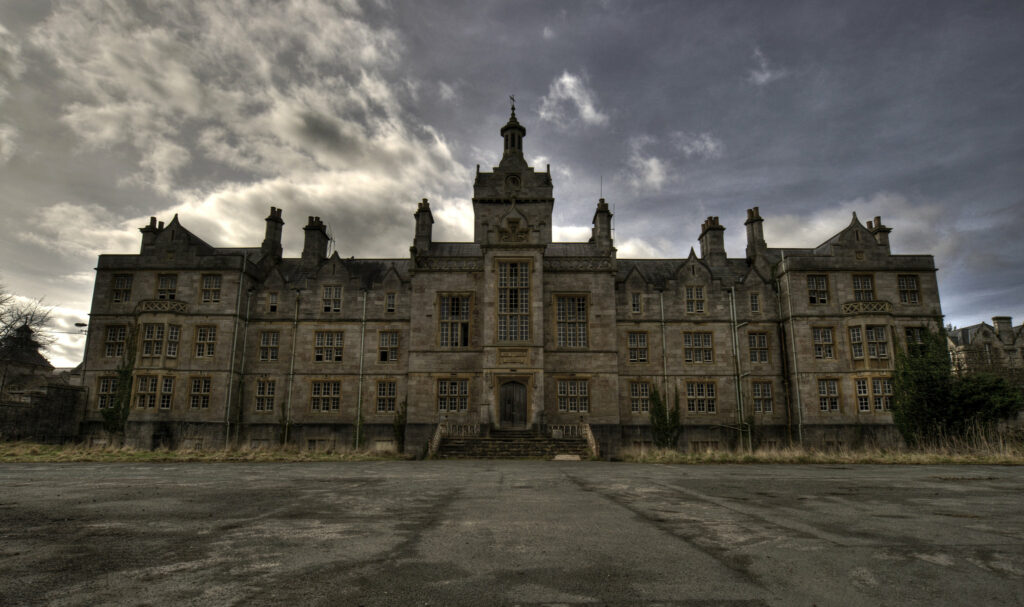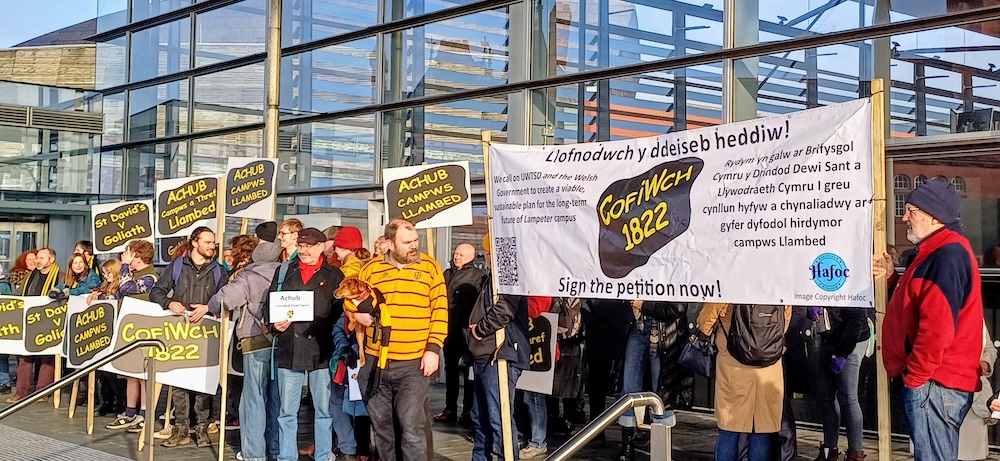Beth McAulay explores the contemporary significance of the North Wales Hospital, or Denbigh Asylum
The ruinous compound sinks into an obscuring overgrowth of bluestem and thistles. At the imposing entrance gates, we are warned by notices, cable-tied and shuddering violently between speared steel bars, that access is prohibited. This is the closest we’re going to get.
I begin with self-incrimination. A decade ago, when I attended school nearby, it was common practice for successive generations of teenagers, lacking all appropriate inhibition, to clamber through clipped wire fencing to trespass onto the grounds of the North Wales Hospital. Since its closure in 1995, it has been subject to a widespread mythologisation that exploits both its forbiddingly wasted Jacobean architecture, as well as its history as a curative institution for the mentally ill. Insulin shock treatment and electroconvulsive therapy were administered onsite, and lobotomies notoriously performed until the 1960s.
It is a landmark that has endured a kind of revisionism that favours the sensational. Speculation pertaining to supernatural activity within the Hospital has invaded the public consciousness, suffused into contemporary folklore. Consequently, it’s been established as a site attractive to paranormal investigators, dark tourists, and blithe intruders alike. The mythos surrounding the Hospital seems to incline visitors to hallucination-inducing paranoia: a plume of spectral smoke in the periphery; a tenebrous figure stilled in a ravaged window frame; a breath down the nape of the neck. Despite more rational scepticism, engagement with the building is now, for many, entrenched in distortive and ineluctable myth.
Whilst I’m considered one of the generation who enjoyed the North Wales Hospital predominantly as a landmark of urban exploration, I recognise that the severity of its disrepair is profoundly regrettable
Nevertheless, one considers the Ouija boards discarded amongst wreckage, and occult iconography inscribed throughout, as little more than evidential of how intently visitors have sought to manufacture a more menacing experience. The myth is self-perpetuating. The building, redundantly sundered from its original community function, now stands as a monument to how even confused translations of history can entirely reconstruct the connotative meaning of a place. By the clumsy curation of graffiti vandals (some of whom insist they only leave marks on areas they’re aware will soon be demolished), the building manifestly exhibits the superstitions that are otherwise abstractly imposed upon it. It’s only unfortunate that such an interpretation of the Hospital’s history partly relies upon specious supposition and regressive attitudes towards mental illness and its remedial practices; indulging in the notion that the building is now infernally populated with tormented revenants. But arguably this is a communal act of reactionary creation: it demonstrates a willingness to engage with local heritage, despite the destructive negligence the building has endured by its successive legitimate guardians.
*
At Denbigh Library, I’m presented with two corpulent binders from the Hospital archive. Noticeably, the rhetoric used to describe trespassers is incendiary and stereotypic. In 1999, the building’s first private buyer, Gerald Hitman, expressed that the site is vulnerable to the ‘tramps, New Age Travellers and dropouts and drug dealers’ who frequent it. It’s a sentiment, albeit otherwise more carefully articulated, that repeatedly features in artefacts pertaining to public engagement with the Hospital. It’s unsurprising, therefore, that attitudes towards the Hospital are generally intergenerationally conflicted.
There’s a prevalent tendency within these articles to generalise trespassers as vindictive, ascribing idle and insolent criminality to what is often mere curiosity. Extensive documentation by urban explorers online – intrepid groups treading carefully over detritus with breath truncated by fascination, serve to prove that many who attend the site are provoked by intrigue. Such a characterisation of trespassers as the sole perpetrators of harm is intrinsically politicised, not least because it has the capacity to distract responsibility for the Hospital’s deterioration onto members of the public. Meanwhile, repeated instances of private buyers being relinquished of their ownership due to derelictions of their custodial obligations, would otherwise indicate that the various owners of the Hospital are equally liable for the atrophic consequences of mismanagement and negligence.
I don’t possess some predisposition towards aestheticising decay. And, whilst I’m considered one of the generation who enjoyed the North Wales Hospital predominantly as a landmark of urban exploration, I recognise that the severity of its disrepair is profoundly regrettable. However, I’m unpersuaded by proposed redevelopment plans – it’s difficult to envision a future for a building increasingly, and rather alluringly, characterised by its slow collapse. Nonetheless, with the North Wales Growth Deal anticipated to supplement council funding by £7m, redevelopment of the site as residential and business units has already commenced. Comparable plans were proposed in 1995, when a report detailing local residents’ responses during an open house conference confirms that the project was contentious. Some note the lack of necessity for extensive new housing in the area, and the possible consequence of overwhelming the town’s facilities. Finally, in 2020, similar concerns were reiterated in a town council meeting regarding the current plans, where it was understood that the prospective homes will be neither foreseeably affordable for many buyers, nor eligible for social housing schemes. With Denbighshire currently suffering a housing crisis, even these apparently hopeful aspects of redevelopment appear less than adequate.
Syniadau uchelgeisiol, awdurdodol a mentrus.
Ymunwch â ni i gyfrannu at wneud Cymru gwell.
Noticeably, the present redevelopment project isn’t inciting protests similar to those its precursors did. Apparent acceptance of these plans by the local community, however, may be symptomatic of resignation rather than endorsement. Whilst it would now be fortunate for any of the pre-existing constructs to be salvaged, the scheme unfortunately, and perhaps unambitiously, intends to prioritise only a small ‘main range’, thus losing a considerable amount of the complex’s grade-listed features.
Retrospective idealism inclines some to wish that the North Wales Hospital had been turned into a museum; or a centre in which the community could sustain an engagement with the social, rather than simply architectural, history of the buildings. Further resistance is also aroused by the plans’ apparent insensitivity to what the Hospital symbolises as a monument to illness. If the building does indeed – as it may reasonably do for past convalescents – represent historical suffering, then such propositions may depend on a process of beautification that is contextually inappropriate.
But here lies the contradiction: a residential redevelopment project may entail a process of reductionism or historical erasure that is still only equivalent to the sensationalism the Hospital in its current state attracts. Its present attractiveness is somewhat contingent on the propagation of fallacy. Arguably, even a museum would need to capitalise on the theatric exhibition of medical artefacts, such as a straightjacket or orbitoclast, which may only stimulate prejudicial attitudes towards mental illness. There is, undoubtedly, complexity in considering how to preserve and present a history affiliated with something as susceptible to misconception and dramatisation as twentieth century mental health care. Conversely, a nurse previously employed at the Hospital suggests that such a public acknowledgement of the institution’s past would actually clarify misunderstandings and instead demonstrate ‘how mental health treatment has evolved’.
I understand, as I’m speaking to her, that the mythology of the North Wales Hospital I’m familiar with conflicts with the realities of older generations’ recent memory. It is, admittedly, an appropriation of the hospital’s past to satisfy the trespasser’s imagination. Instead, the Hospital is upheld by those with experience predating 1995 as an institution that demonstrated excellent psychotherapeutic care, and nurtured an indelible sense of community that permeated the town of Denbigh itself. Though treatment was comparably more dependent on psychiatric drugs than the more widely practised talking therapies of today, patients were encouraged to enjoy aspects of ordinary life. It was more ‘humane’, she asserts, than is potentially presupposed. The Hospital and its residents were wholly integrated into the locality, ensuring an invulnerability to the alienating effects of stigma that mental health facilities sometimes endure. Employment there became a matter of familial legacy; it sustained and still sustains a deep communal pride. Moreover, the closure of the Hospital not only appears to have a causal relationship with the economic decline of Denbigh itself, but has also inflicted a profound ‘loss to mental health nursing’. The nurse and I are indeed united in a sense of loss that compels us both to oppose the redevelopment plans, but it’s as though we’re each seeking the preservation of two distinctly separate monuments.
The Hospital offers an intriguing phenomenological inquiry into how divergent perceptions have consequently made it a place that feels intermundane
The interior of the Hospital is vast and labyrinthine. Staircases abruptly lead to platform-less voids that plummet to floors beneath. Heaps of distressed wood and shards of peeled lead paint assemble a crust over the ground and make every step perilous. One becomes concerned that the air is tangibly textured with fibrous splinters of asbestos. It is dangerous, and in advocating for unrestricted exploration, I risk endorsing a multitude of irresponsible and condemnable behaviours. Advocation for trespass on the grounds of such a dangerous and endangered building is inherently aporetic. What cannot be disregarded, however, is how the Hospital’s deterioration has allowed it to be reconceptualised; and how that post-closure reinterpretation constitutes the memories of its innumerable trespassers.
Indeed, the North Wales Hospital offers an intriguing phenomenological inquiry into how divergent perceptions have consequently made it a place that feels intermundane. A place that is simultaneously busied with metaphoric ghosts and paralysed by neglect, stretched and thinned between epochs, is too saturated with various significances to dismantle without disturbing what the buildings have come to mean within collective imaginations. Perhaps I’ve retained the seditious impulse I held during my years of trespass, or am simply concerned that physical demolition of the Hospital will also entail a cleansing and purging of its abundant connotations, its palimpsestic histories.
All articles published on the welsh agenda are subject to IWA’s disclaimer. If you want to support our work tackling Wales’ key challenges, consider becoming a member.





